An experiment in military airlift, playing out at a former Warsaw Pact base in central Hungary, is being watched with great interest by many members of NATO.
Twelve nations have come together to jointly own and operate a trio of C-17 heavy cargo aircraft, sharing flying hours and costs according to their various needs. If the experiment succeeds, it could be a model for how NATO members, pressed by withering defense budgets, can buy military capabilities they must have, at a price they can bear.
So far—and to the surprise of many—the experiment seems to be a success. The arrangement, called the Strategic Airlift Capability (SAC), is unique. The consortium comprises 10 NATO members and two other countries.
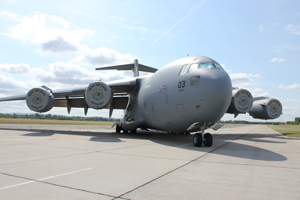 |
A C-17 on the ramp at Papa AB, Hungary. (Staff photo by John A. Tirpak) |
Though it has a military hierarchy, it is not under NATO command, nor is it an entity of the European Union or the United Nations. The SAC is controlled by a steering committee (chaired by a US Air Force general officer, currently Maj. Gen. Mark O. Schissler) that allocates flying time based on participant requests and contributions. Its operational organization, called the Heavy Airlift Wing (HAW), has been led by USAF officers, currently Col. Keith P. Boone. His successor is scheduled to be a Dutch Air Force officer.
“I suspect there were a lot of skeptics” that the consortium approach would work, said Schissler, head of plans and policy for US European Command.
Speaking during the HAW’s first change-of-command ceremony in June at Papa AB, Hungary, where SAC is headquartered, Schissler—the chair of the SAC steering committee—ran down a list of the HAW’s achievements. He noted that the wing went from concept to the start of base operations “in just two-and-a-half years” and has since amassed more than 4,500 flying hours without a safety mishap. “Way too many” of those hours were in combat situations in Afghanistan, Schissler said.
This achievement is recognized as “truly amazing” by diplomats and military professionals who thought the details of running a military entity by international committee—each member having its own foreign policy and security objectives—would be impossibly complicated, he added. “It’s only been five years” since the concept was first broached, Schissler said. He paid tribute to the members for their commitment to make the concept work in spite of “the political upheaval of the last few years,” chalking it up to each country contributing “some very talented people” to the enterprise.
The SAC consortium was conceived in 2006, when a number of NATO nations identified a need for long-range, outsize cargo capacity beyond the performance of tactical airlifters, such as the C-130. Sweden, a neutral nation belonging to the EU but not NATO, was deep in negotiations to buy C-17s from Boeing. It needed a capability to move people and large equipment directly to forward locations half a world away to meet its UN peacekeeping commitments. However, the cost of buying and supporting the aircraft on its own was a serious financial challenge for Sweden.
Other nations facing a similar requirement wondered whether a group buy was feasible. NATO looked at an Alliance purchase of heavy lift aircraft, taking as precedent its common acquisition, manning, and operation of the E-3 AWACS. However, because Sweden—and later Finland—were likely participants but not NATO members, the arrangement moved outside the Alliance.
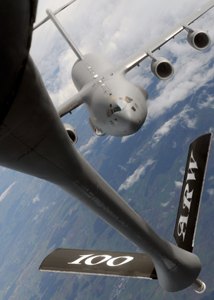 |
A HAW C-17 approaches the boom of a 100th Air Refueling Wing KC-135 during a training mission over Germany . (USAF photo by SrA. Tabitha M. Lee) |
Cultural, Language Barriers
There was some urgency to do a deal. Boeing had announced that, without further orders from the Air Force or foreign buyers, it would begin shutting down the C-17 production line. It was the last chance to “get in on” the C-17 before the line closed.
Eventually, a deal was struck. The charter members in the SAC were the NATO members Bulgaria, Estonia, Hungary, Lithuania, the Netherlands, Norway, Poland, Romania, Slovenia, and the United States, plus non-NATO Partnership for Peace countries Sweden and Finland.
The US contributed one of three C-17s, a third of the personnel, and a third of the cost. Hungary offered Papa—an underused base fairly central to member countries in Eastern Europe—as the unit headquarters and operating location. Most participants provide aircrews; some of the less affluent countries provide security forces and other personnel for the base. The three C-17s bear the markings of Hungary and the minimalist identifier “SAC.”
Since going operational, the HAW has routinely moved personnel and supplies from Europe to NATO bases in Afghanistan, but has also taken relief supplies to Pakistani flood victims and flown to Haiti in the aftermath of the powerful 2010 earthquake. The ability of countries such as Hungary to make a gesture like that to Haiti or Pakistan is a source of great national pride, said HAW officials.
The HAW is “a great arrangement for every country that belongs to it,” Schissler observed, “because we gain something that none of us have enough of, which is strategic airlift.”
For the smaller countries, he said, “it brings them access to a whole group of nations on a regular basis.” There is also “some prestige being associated with this multinational effort. … It’s absolutely historic. You can’t find another unit that stood up and flew combat a month after getting their first airplane. It just doesn’t happen.”
The US provides the consortium with crew training at its C-17 schoolhouse—Altus AFB, Okla.—through the Foreign Military Sales program. Because the C-17 is an American aircraft and crews are schooled at an American base, initial regulations and procedures were grafted from USAF wholesale. That is gradually changing, said Lt. Col. Christian Langfeldt, the HAW’s director of operations.
Langfeldt, of the Norwegian Air Force, said the principal challenges facing the unit are “the culture [and] the language barrier. We have to translate everything two times.”
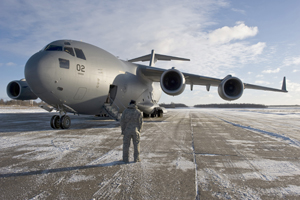 |
|
There are other cultural hurdles. Norway’s air force, for example, has no enlisted personnel, only officers. Some countries’ personnel are forbidden to work more than 40 hours a week, and there are different rules regarding crew days and crew rest periods, for example. “The regulations are different for all the varying countries,” Langfeldt said. “You have to understand [that] things are different, [and] how you receive words is important.”
USAF regulations are gradually being shifted to account for the HAW’s unique mix of people and national styles. “We’re making it our own,” he said. “We try to show the Americans that it is possible to do it in different ways.”
Langfeldt said the various participants have sent quality people to the unit. They want to “put their best foot forward,” he said. Pilots, though, come with varied backgrounds; some with more experience, some with less. “Some of us have never flown a brand-new airplane,” Langfeldt noted. However, “the job is new and has international importance. It’s an opportunity for all of us. …We’re all learning together.”
Routine is important, and the runs to Afghanistan represent the most common mission flown by the HAW, Langfeldt noted. “Once or twice a week, we go to Afghanistan. We go to all the key places in the [area of responsibility].”
He pointed out that “crossing into Afghanistan is crossing into combat,” and not all participants are in that fight. “All the nations have the prerogative to opt out of participating in a mission,” he explained. “In some instances, yes, some partners won’t do a mission. Some crew members can’t be assigned to some missions because of a national sensitivity. Some nations have a list of places their people can’t go.”
Schissler said such national sensitivities and prohibitions are things that must be worked out at the committee level. While no member can veto a mission, they can refrain from participating. Flying hours allocated to each member have to take these sensitivities into account.
The HAW only has about 140 personnel, drawn in various numbers from the participants. At Papa, a wide variety of uniforms are worn. There is no HAW uniform, and salutes are usually reserved for a higher-ranking person from one’s own air force. Boone can direct personnel in the unit, but he cannot impose discipline on anyone who is not in the US Air Force, nor can he order anyone to support a mission that person’s country has not approved.
The steering committee meets four times a year for a heavy series of meetings to plan the use of the aircraft, which are budgeted for 3,165 hours a year, or roughly 1,000 hours per airplane, although the actual hours flown in 2010 was about 2,800 hours across the fleet. It tries to plan the use of the aircraft as far ahead as possible, but some wiggle room is built in to accommodate pop-up requirements. In the event of a conflict that can’t be resolved, the nations have agreed to let the HAW commander make the final call.
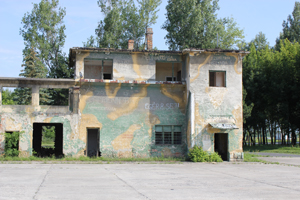 |
Facilities at Papa range from Cold War-era derelicts (top) to a recently updated control tower, maintenance hangar, and administrative building. (Staff photos by John A. Tirpak) |
So far, he has not had to serve as tiebreaker.
Papa’s Shortcomings
A rail line runs adjacent to the base, and much heavy gear can be brought to the airplanes for transport, although one senior officer described the condition of the rail trans-shipment capability as “suboptimal,” because the train freight ramp can’t bear the weight of some heavier cargo. An upgrade is on the list of “things to do.”
There is plenty of room at Papa for the C-17 operation. The base was sized to receive large contingents of Soviet and Warsaw Pact aircraft in the event the Cold War turned hot. There are many camouflaged hardened aircraft shelters at the base; these are now used for storage. The other main base tenant carries out a helicopter mission using only a fraction of the space, and a few old MiG-21s are parked on the apron.
Some of the buildings at Papa are derelict and covered with graffiti, but the principal maintenance building is shiny white and blue, bearing the corporate logo of Boeing, which provides contractor logistics support for the HAW’s C-17s. About 50 Boeing personnel work at the base and perform nearly all of the aircraft maintenance, although HAW personnel serve as crew chiefs. Several other buildings have been renovated for living, dining, and office support functions.
HAW personnel privately acknowledge Papa’s main shortcoming is the lack of a hangar that can enclose an entire C-17. The wind and cold of the Hungarian cornfields surrounding Papa can make maintenance on the big airplanes a trial in winter.
“Think Minot,” one USAF member of the HAW said, referring to the Air Force base in North Dakota. “Imagine Minot in winter without a hangar to work in.” The issue has the attention of the steering committee, and is stimulating a debate about whether to stay at Papa, due to a financial windfall coming to the SAC.
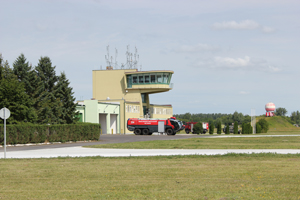 |
Facilities at Papa range from Cold War-era derelicts (top) to a recently updated control tower, maintenance hangar, and administrative building. (Staff photos by John A. Tirpak) |
The HAW’s three aircraft were bought in a hurry because Boeing was getting ready to shut down the C-17 production line. Since then, however, Boeing has gone on to build dozens more of the cargo airplanes, both for the Air Force and foreign customers. India, for example, recently signed on to buy 10, and the backlog will take a few years to work off. Since the price was based in part on the amortized cost of C-17 development and production run, the SAC could get a refund from Boeing and the FMS program of anywhere from $90 million to $130 million.
A C-17-sized hangar on the base is estimated to cost about $44 million to build. It would be worth the investment since the SAC was structured as a 30-year, $5 billion operation, and at present, the aircraft must make the journey to Jackson, Miss., to have major checks performed. Another nice-to-have capability would be a simulator at the base. Flight crews must go to Jackson for upgrades and full-motion emergency procedures training and refreshers.
However, the windfall could also get the consortium halfway to buying a fourth airplane, which all the members agree they could certainly use.
Another consideration is Italy. Italy nearly signed on to be a SAC participant, and its strategic lift needs have not diminished. “There is talk,” said one SAC member, “that Italy might want to come in [to the group] and offer us a base to operate out of.”
If Italy joins—and if a sufficiently large hangar is available at a new base, or if the climate is suitably more forgiving there—the steering group might lean closer to buying the fourth airplane than a hangar at Papa. “We are thinking about this slowly and carefully,” one steering group member said. “Building a hangar here [at Papa] would make us ‘married’ to this base.”
A fourth airplane would smooth some of the bumps of operating with such a small contingent of aircraft.
Col. John D. Zazworsky Jr., former HAW commander, said in a speech at the change-of-command ceremony that he was leaving incoming commander Boone “one aircraft hard broke in Afghanistan, one aircraft hard broke behind me, and six priority missions that have to go by Tuesday.”
“Good luck,” he joked. Zazworsky reassured his relief that the situation was abnormal, however.
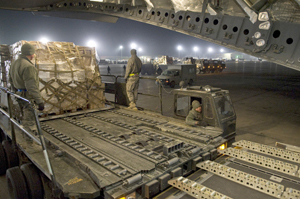 |
|
The SAC charter does not exclude new members from joining, and another steering group member said that there are a number of nations, already “sold” on the idea of the consortium, that may ask to join. Though the committee member declined to name any nations that have asked formally for information, he noted that Germany and France will have to wait an extended period to get their EADS A400s in service. The A400—the European prop-driven heavy lifter sized between the C-17 and the C-130—is to add strategic airlift capability and replace C-160 Transalls, which will retire before their replacements arrive.
A Valid Model
Schissler said joining the SAC could “bridge” those countries until they get their new aircraft.
“I think it’s likely” that more nations will join the SAC, he said.
“There [are] indicators out there that other nations that aren’t currently members are considering the benefits of the consortium, a shared airlift capability. And that’s good for the HAW. They could absorb some new members.”
Adding more members would complicate the division of flying hours, but the group has shown it’s up to the challenge, he said.
“Because this is an operational reality,” the steering committee finds ways “to make things work and do them safely, and [finds] ways to agree. They are all equally invested at different values, depending on the size of their contribution, … but they’re fully invested to the degree they can be, … in money, people, and the operation itself.”
Schissler said the fact that the HAW works is “remarkable.”
“It’s hard enough to fly an airline. They’re flying military airplanes and they’re doing it every day.” He added that, despite the NATO joint program on E-3 AWACS and another in the works for airborne ground-mapping radar and moving target indication, “there is no exact analogy for this. It is one of a kind.”
Even though the HAW has had its full complement of three aircraft for some time now, the unit has not been declared at full operational capability. That determination will be made by the commander only when a series of criteria that go well beyond having all its airplanes has been fulfilled. Papa has no certified de-icing capability, for example, which means the base can’t serve as a transient alert facility. Eventually, such deficiencies will be corrected.
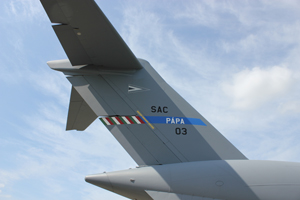 |
The SAC could well serve as a model for other jointly owned and operated assets. Tails of the three aircraft wear Hungary’s colors to recognize the unit’s host. (Staff photo by John A. Tirpak) |
If more nations in Europe wanted to get in on strategic airlift, they would probably join the SAC, Schissler said. However, if European countries hard-pressed by shrinking defense budgets wanted to create a similar shared-use arrangement for another kind of capability—fighters or remotely piloted aircraft, for example—they would probably have to create separate consortia.
“There wouldn’t be any direct relationship to the SAC because it’s a one-of-a-kind entity. It serves as a model.”
A tactical airlift consortium could follow the Papa pattern almost exactly, he said; the only difference would be the size of the manifests and duration of the missions.
Creating a fighter consortium would be harder, Schissler admits, because the members would have to work out who can give attack orders, and under what conditions; the rulebook would be far more elaborate than it is just for moving cargo.
Gen. Mark A. Welsh III, commander of US Air Forces in Europe, said in a June interview that other countries are watching the Papa experiment closely.
“Most of the countries [in NATO] have taken a look at the Heavy Airlift Wing and said, ‘You know, that is a model for the future.’ “
To get started, Welsh said the countries have to openly state “that they have a need” and the ability to “build capability in that area—whatever consortium area that is, whether it’s [intelligence-surveillance-reconnaissance] or tactical airlift or air policing capabilities.”
Schissler asserted, “The model is valid. That’s something we proved, here. It is possible to set up a multinational organization. … Pool your money, your resources, your people, talent, and your training, and everybody brings contributions [and] you can make it work.”